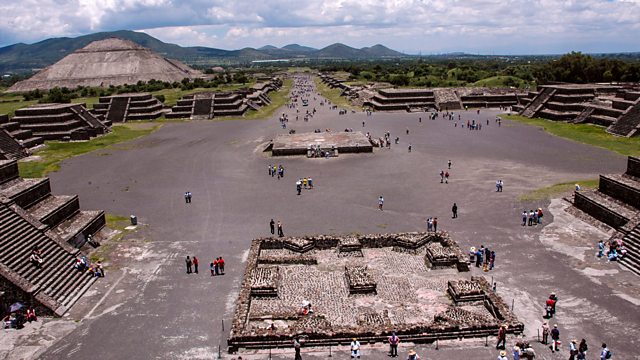Around the World in 80 Treasures episode 2 – Mexico to America: Dan Cruickshank’s travels take him from ancient Mayan tombs and the giant warriors of Tula in Mexico to Thomas Jefferson’s home in Virginia and the Statue of Liberty.
In episode two of Dan Cruickshank’s global journey to find the top 80 man-made treasures in history, we travel from the mysteries of ancient Mayan tombs to that great symbol of the modern age – the Statue of Liberty, while taking in the drama of the giant warriors at Tula and the refinement of Thomas Jefferson’s elegant home in Virginia. Dan also reveals his first dark treasures of this monumental journey – the ruthlessly efficient killer, the 1851 Navy Colt – the handgun that ‘won’ the west for the white man – and comes face to face with the ‘Controller of the Universe’ in Mexico City.
Elsewhere in Mexico, deep inside the pyramids of Palenque, Dan finds the great tomb of King Pacal. Even more surprising is the early civilisation of North America at Mesa Verde, where the clifftop people created a brilliant landscape that looks like something from outer space. From there it’s an extraordinary leap to the high rise drama of Manhattan and the skyscraper that changed the world.
Around the World in 80 Treasures episode 2 – Mexico to America
Palenque
Palenque, also anciently known as Lakamha, was a Maya city state in southern Mexico that perished in the 7th century. The Palenque ruins date from ca. 226 BC to ca. 799 AD. After its decline, it was overgrown by the jungle of cedar, mahogany, and sapodilla trees, but has since been excavated and restored. It is located near the Usumacinta River in the Mexican state of Chiapas, about 130 km (81 mi) south of Ciudad del Carmen, 150 meters (490 ft) above sea level. It averages a humid 26 °C (79 °F) with roughly 2,160 millimeters (85 in) of rain a year.
Palenque is a medium-sized site, smaller than Tikal, Chichen Itza, or Copán, but it contains some of the finest architecture, sculpture, roof comb and bas-relief carvings that the Mayas produced. Much of the history of Palenque has been reconstructed from reading the hieroglyphic inscriptions on the many monuments; historians now have a long sequence of the ruling dynasty of Palenque in the 5th century and extensive knowledge of the city-state’s rivalry with other states such as Calakmul and Toniná. The most famous ruler of Palenque was K’inich Janaab Pakal, or Pacal the Great, whose tomb has been found and excavated in the Temple of the Inscriptions.
By 2005, the discovered area covered up to 2.5 km2 (1 sq mi), but it is estimated that less than 10% of the total area of the city is explored, leaving more than a thousand structures still covered by jungle. Palenque received 920,470 visitors in 2017.
Mesa Verde National Park
Mesa Verde National Park is an American national park and UNESCO World Heritage Site located in Montezuma County, Colorado. The park protects some of the best-preserved Ancestral Puebloan archaeological sites in the United States.
Established by Congress and President Theodore Roosevelt in 1906, the park occupies 52,485 acres (21,240 ha) near the Four Corners region of the American Southwest. With more than 5,000 sites, including 600 cliff dwellings,[2] it is the largest archaeological preserve in the United States.[3] Mesa Verde (Spanish for “green table”) is best known for structures such as Cliff Palace, thought to be the largest cliff dwelling in North America.
Starting c. 7500 BC Mesa Verde was seasonally inhabited by a group of nomadic Paleo-Indians known as the Foothills Mountain Complex. The variety of projectile points found in the region indicates they were influenced by surrounding areas, including the Great Basin, the San Juan Basin, and the Rio Grande Valley. Later, Archaic people established semi-permanent rock shelters in and around the mesa. By 1000 BC, the Basketmaker culture emerged from the local Archaic population, and by 750 AD the Ancestral Puebloans had developed from the Basketmaker culture.
The Mesa Verdeans survived using a combination of hunting, gathering, and subsistence farming of crops such as corn, beans, and squash. They built the mesa’s first pueblos sometime after 650, and by the end of the 12th century, they began to construct the massive cliff dwellings for which the park is best known. By 1285, following a period of social and environmental instability driven by a series of severe and prolonged droughts, they abandoned the area and moved south to locations in Arizona and New Mexico, including the Rio Chama, the Rio Grande Valley, the Pajarito Plateau, and Santa Fe.




